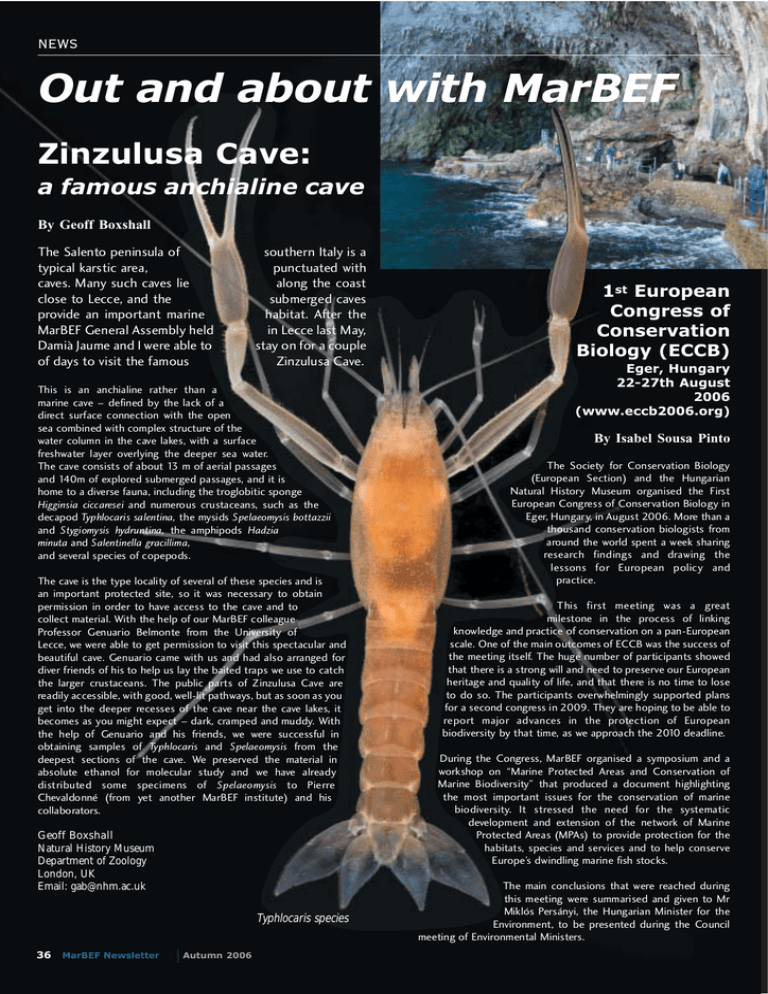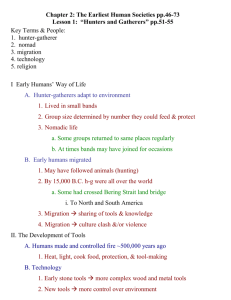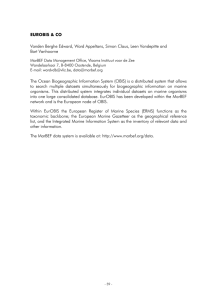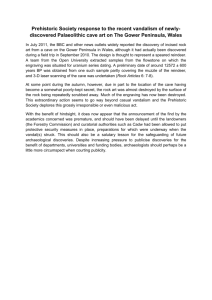1 European Congress of Conservation
advertisement

NEWS Out and about with MarBEF Zinzulusa Cave: a famous anchialine cave By Geoff Boxshall The Salento peninsula of typical karstic area, caves. Many such caves lie close to Lecce, and the provide an important marine MarBEF General Assembly held Damià Jaume and I were able to of days to visit the famous southern Italy is a punctuated with along the coast submerged caves habitat. After the in Lecce last May, stay on for a couple Zinzulusa Cave. This is an anchialine rather than a marine cave – defined by the lack of a direct surface connection with the open sea combined with complex structure of the water column in the cave lakes, with a surface freshwater layer overlying the deeper sea water. The cave consists of about 13 m of aerial passages and 140m of explored submerged passages, and it is home to a diverse fauna, including the troglobitic sponge Higginsia ciccaresei and numerous crustaceans, such as the decapod Typhlocaris salentina, the mysids Spelaeomysis bottazzii and Stygiomysis hydruntina, the amphipods Hadzia minuta and Salentinella gracillima, and several species of copepods. The cave is the type locality of several of these species and is an important protected site, so it was necessary to obtain permission in order to have access to the cave and to collect material. With the help of our MarBEF colleague Professor Genuario Belmonte from the University of Lecce, we were able to get permission to visit this spectacular and beautiful cave. Genuario came with us and had also arranged for diver friends of his to help us lay the baited traps we use to catch the larger crustaceans. The public parts of Zinzulusa Cave are readily accessible, with good, well-lit pathways, but as soon as you get into the deeper recesses of the cave near the cave lakes, it becomes as you might expect – dark, cramped and muddy. With the help of Genuario and his friends, we were successful in obtaining samples of Typhlocaris and Spelaeomysis from the deepest sections of the cave. We preserved the material in absolute ethanol for molecular study and we have already distributed some specimens of Spelaeomysis to Pierre Chevaldonné (from yet another MarBEF institute) and his collaborators. Geoff Boxshall Natural History Museum Department of Zoology London, UK Email: gab@nhm.ac.uk Typhlocaris species 36 MarBEF Newsletter Autumn 2006 1st European Congress of Conservation Biology (ECCB) Eger, Hungary 22-27th August 2006 (www.eccb2006.org) By Isabel Sousa Pinto The Society for Conservation Biology (European Section) and the Hungarian Natural History Museum organised the First European Congress of Conservation Biology in Eger, Hungary, in August 2006. More than a thousand conservation biologists from around the world spent a week sharing research findings and drawing the lessons for European policy and practice. This first meeting was a great milestone in the process of linking knowledge and practice of conservation on a pan-European scale. One of the main outcomes of ECCB was the success of the meeting itself. The huge number of participants showed that there is a strong will and need to preserve our European heritage and quality of life, and that there is no time to lose to do so. The participants overwhelmingly supported plans for a second congress in 2009. They are hoping to be able to report major advances in the protection of European biodiversity by that time, as we approach the 2010 deadline. During the Congress, MarBEF organised a symposium and a workshop on “Marine Protected Areas and Conservation of Marine Biodiversity” that produced a document highlighting the most important issues for the conservation of marine biodiversity. It stressed the need for the systematic development and extension of the network of Marine Protected Areas (MPAs) to provide protection for the habitats, species and services and to help conserve Europe’s dwindling marine fish stocks. The main conclusions that were reached during this meeting were summarised and given to Mr Miklós Persányi, the Hungarian Minister for the Environment, to be presented during the Council meeting of Environmental Ministers.






